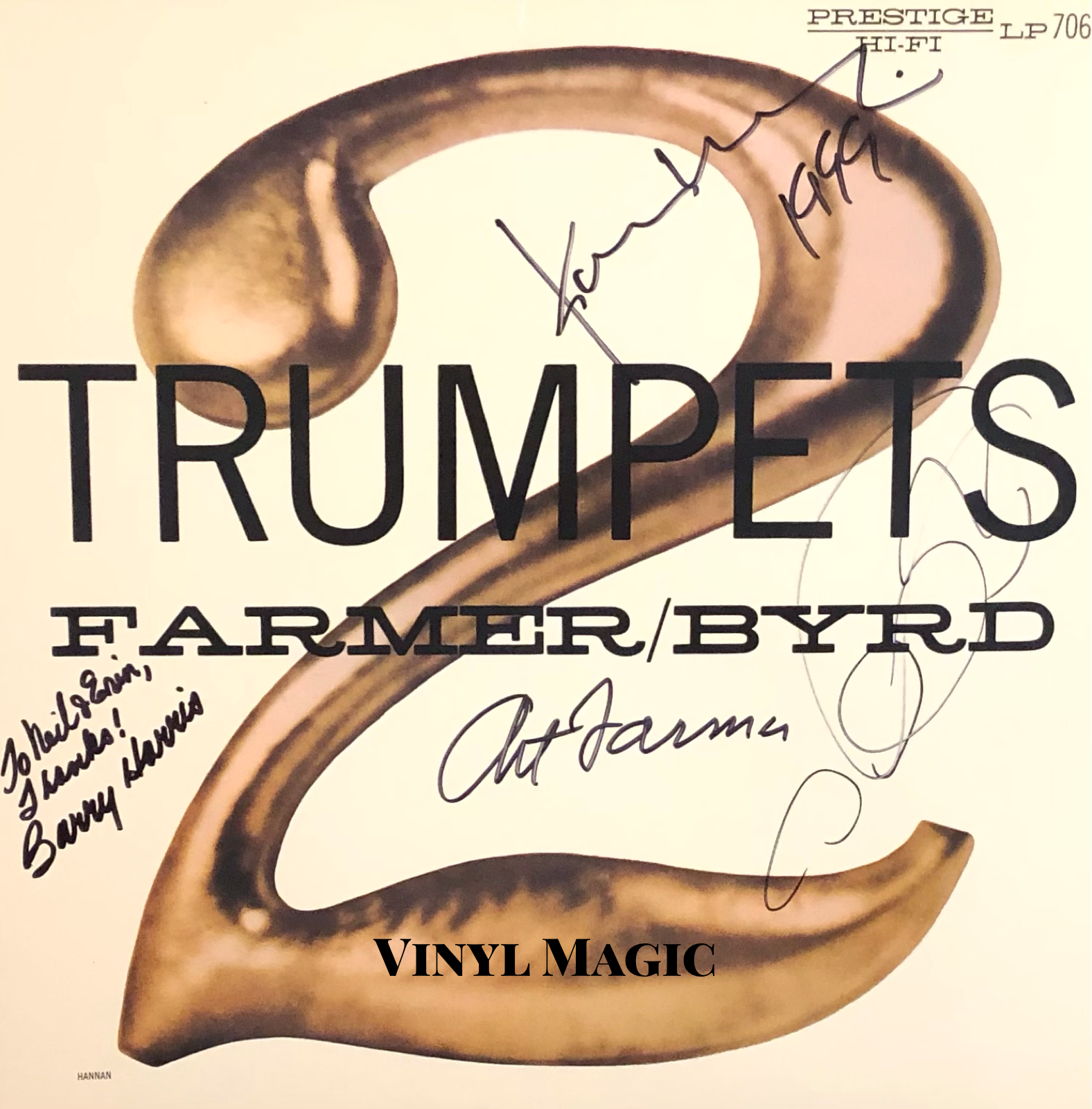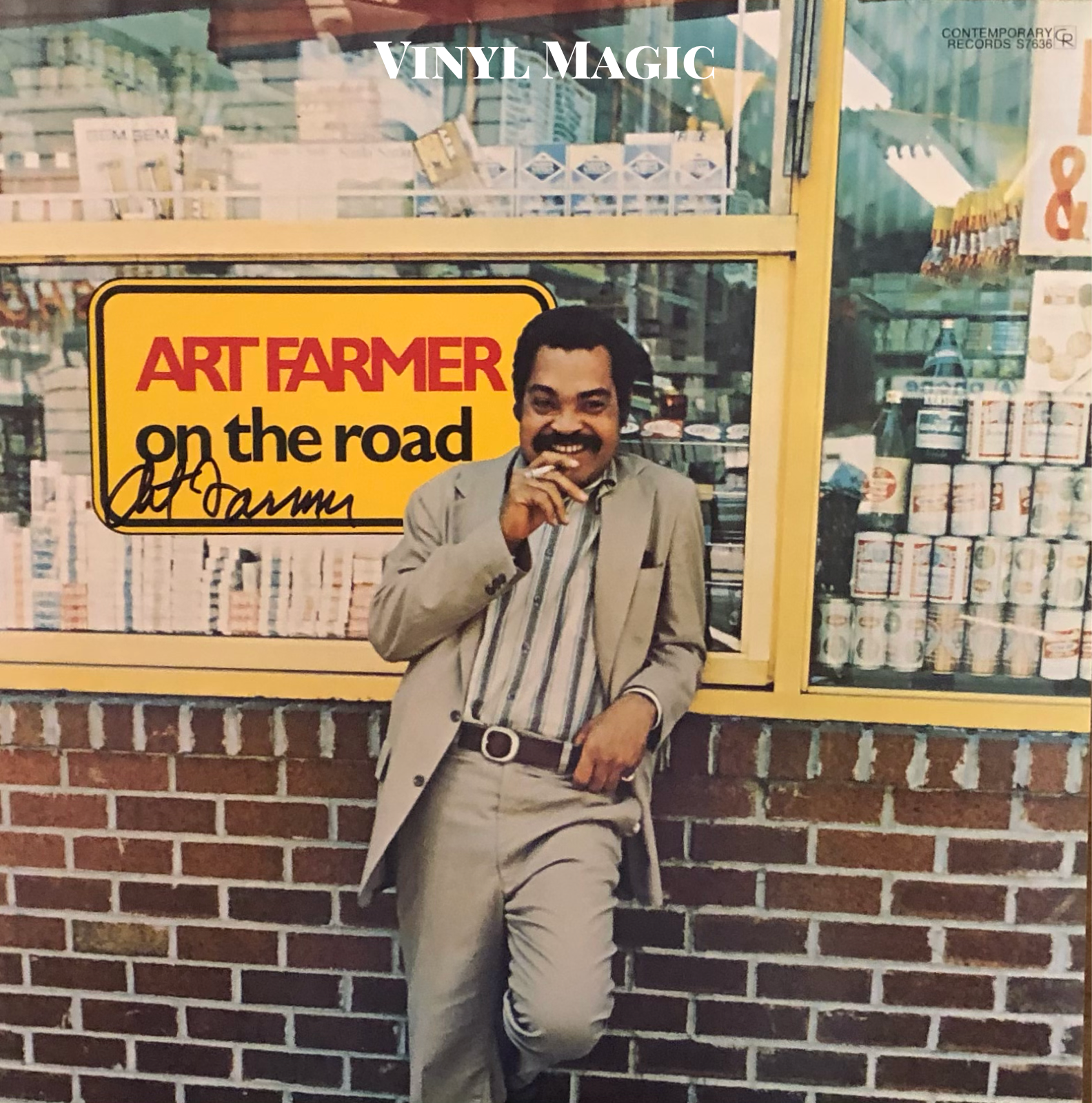Art Farmer and Me...
I started off studying the piano, because that’s the first instrument that I ever heard. My mother used to play the piano with her father’s church choir. At that time, it was very customary to have a piano in the house, and someone played it. There were a lot of music students in our family, and it just seemed the natural thing to take piano lessons. Then after that, when we were living in Phoenix, Arizona, a man gave me a violin, and I studied that for a couple of years. Then I switched from the violin to the bass tuba. I was playing with a marching band that was part of a church organization in Phoenix. I heard some of the older guys in the band jamming around one day, and I wanted to play a horn, but the only horn available was the tuba.
Art Farmer
The Art Farmer Septet (1954) signed by Art
Louis Armstrong was the well where you go to for the water. You know, he was the source. And if somebody could come along and say as much as Miles said, and you couldn’t hear Louis Armstrong in it, that was really a miracle to me. I’m certainly not putting down Louis Armstrong. As I said, I haven’t heard anything greater than Louis Armstrong, nothing as far as an individual instrument. The emotion that he could get out of that horn, there’s nothing around like that.
Art Farmer on Louis Armstrong and Miles Davis
Art Farmer Quintet (1955) signed by Art
You listen to everyone, and you try to get some of their quality. I certainly listened a whole lot to saxophone players — Johnny Hodges and Charlie Parker and Ben Webster and Lester Young — for dynamics and for phrasing, and just getting around the music. The last thing a person should do is just listen to their own instrument, because that limits you so much. It’s just unnecessary to put yourself in a situation where you’re dealing with that kind of limitation. It’s like you’re just listening to half of the world…you’re just saying, 'I don’t want to know anything else.' There’s no point in that.
Art Farmer
When Farmer Met Gryce (1955) signed by Art
The flumpet? I hate that name, but I'm stuck with it! That was made by a trumpet-maker named David Monette, who makes trumpets for a lot of very fine trumpet players, such as Wynton Marsalis and the principal players for the Boston Symphony and the Chicago Symphony. I asked him to make me a trumpet and he made it. It was very fine and I started really working on the trumpet. Then he got the idea that it really didn't sound like me, but he wanted to make a flugelhorn for me. So I told him to go ahead and do it. Then he called up one day and he said, "Well, I made it very carefully and put every part in order, made it by hand, but it sounds like hell, and I really don't like it. But I have another idea." So I told him to go ahead and make it. Then a couple of months later, he called and said, "It's ready." I went to Chicago, where I was booked, and he brought it to the gig. Right from the start, it sounded like the answer to my prayers. You could go one way or the other on it. You could approximate the warmth of the flugelhorn, or you could approximate the projection of the trumpet. If you really wanted to put a note out there, you could do it, and if you wanted to be more intimate, you could do that also.
Art Farmer on the origin of the 'flumpet'
2 Trumpets (1956) signed by Art, Donald Byrd, Barry Harris, Jackie McLean
Born in 1928 in Council Bluffs, Iowa, Art Farmer was raised in Phoenix, Arizona, a neglected jazz outpost in the 1940s. As he recalled, "A lot of bands didn't come through Phoenix. Phoenix was a relatively small town. Billy Eckstine never came through, Earl Hines never came through, Duke Ellington never came through, nor Count Basie. But I certainly remember the ones that did come through. When I heard Jimmie Lunceford's trumpet section, well, I knew what my life was going to be instantly." And what a wonderful life in jazz ensued!
The Jazz Soul Of Porgy & Bess (1959) signed by Art, Herbie Powell, Harry “Sweets” Edison
An acclaimed band leader, composer, innovator, and trumpeter, Art Farmer released more than sixty albums as a leader, and appeared on hundreds more as a session player, alongside jazz icons, Donald Byrd, Benny Carter, Lionel Hampton, and Sonny Rollins. But first, Art had to get out of Phoenix. Despite his mother's reservations about her twin boys leaving home at age sixteen, Art headed west to Los Angeles with his brother Addison before they graduated from high school.
On The Road (1976) signed by Art
Art remembered, "We actually went there supposedly on a vacation. We had had our little day jobs and saved our money, and we went over to Los Angeles for a couple of weeks. But the music scene was so alive on Central Avenue in Los Angeles, and we heard so many people, it just seemed senseless to go back to Arizona. So we decided to stay there and finish our high school there, and support ourselves by whatever means were possible. You could just walk up the street and go from one club to the other. Within an area of about 20 blocks there would be like five or six clubs. These clubs were forced to close by one o’clock because of wartime restrictions, but then there were some other clubs that would open up. I don’t think they were quite legal, but they got away with it some way. They would open up when the first clubs closed, and they would stay open until maybe six or seven o’clock in the morning." It was heady stuff for teenagers, and Art and brother Addison were committed to making a name for themselves in music, and they did.
To Duke With Love (1975) signed by Art, Billy Higgins, Cedar Walton
The Summer Knows (1976) signed by Art, Billy Higgins, Cedar Walton
Whether performing in bands led by Johnny Otis, Jay McShann, and Benny Carter, or participating in Central Avenue jam sessions, Art worked on his technique, with its warm, lovely and lyrical phrasing. He said, "I decided to work on sound, because it seemed like most of the guys my age were just working on speed." Art wisely straddled both swing and bebop. A flurry of frenetic notes was never his primary aim or skill, Art was adept at swing, especially on ruminative ballads. His education continued when he joined the Lionel Hampton Orchestra for a European tour, "The music wasn't easy. I was lucky to be there, and the more experienced sidemen were very helpful. That's one thing about the music business...when people see that you're serious about learning, well, then, they'll bend over backwards to give you a helping hand. That's what keeps the music alive, I think." When Art returned, he moved to New York City, and his recording career began in earnest in 1953.
Meet The Jazztet (1960) signed by Art, Benny Golson, McCoy Tyner, Curtis Fuller
Thirteen albums quickly followed until Art joined his musical soul mate, Benny Golson, and they formed The Jazztet in 1959. Their first recording, Meet The Jazztet, featured a nineteen year old wunderkind, pianist McCoy Tyner and the great trombonist Curtis Fuller. Benny Golson was the principal songwriter and "I Remember Clifford", "Blues March" and "Killer Joe" became essential Golson jazz standards. Art remarked, "The thing that really attracted me to Benny was the warmth of his ensemble writing. That was one of the things that you could hear in The Jazztet. With three horns, you could get a certain depth that you couldn't get with two horns. Nobody was writing for three horns until Benny came along and started writing for The Jazztet." A fruitful and enduring partnership, Benny and Art released twelve albums as The Jazztet with Curtis Fuller, and they recorded and toured sporadically for the next twenty-six years.
Another Git Together (1962) signed by Art, Benny Golson, Harold Mabern
From 1962 on, Art concentrated on the flugelhorn (and later, the flumpet!). Less taxing on the embouchure and easier to play, the flugelhorn afforded a warm, burnished sound with a fatter timbre. Art explained, "In certain rooms, the trumpet sounded very brassy and piercing, and it just didn't blend in the way I wanted it to do. I remembered that I had heard some other people like Clark Terry playing the flugelhorn, and I had heard a recording that Miles Davis had done playing the flugelhorn, and I felt I should give it a try." It remained a powerful weapon in Art's music arsenal.
From Vienna With Art (1970) signed by Art, Jimmy Heath, Jimmy Woode
By 1968, as social unrest abounded and rock music eclipsed jazz, Art moved to Vienna, joined the Austrian Radio Orchestra and jammed with other expatriates Dexter Gordon, Don Byas, Ben Webster and Johnny Griffin. As he wryly observed, "There were more of them over there than over here at that time." Art would remain in Vienna until the early 1980s when he became a fixture again at New York City jazz clubs, the Blue Note, Sweet Basil, and the Village Vanguard, and he kept residences in New York and Vienna until his death in 1999.
Back To The City (1986) signed by Art, Benny Golson, Curtis Fuller
Erin and I saw The Jazztet perform in the early 1980s in Washington, DC, and we saw Art many times with his quartet in jazz clubs in New York City. He was always kind and generous, if a little weary and taciturn off stage. There was a palpable sadness as Art peered at me through his doleful eyes as he looked at his albums. I couldn't help but wonder if the tragic loss of his identical twin brother (accomplished bassist and Jazztet member) Addison to a cerebral hemorrhage thirty years earlier had left a searing memory. I never asked him directly, but there seemed an unspoken, profound loss. Perhaps that's why Art excelled playing blues and ballads, he came by his wistful melancholy deeply. He signed the vinyl with nary a comment, happy to inscribe, little to say. And I was happy sharing his time, happier still for the beauty and legacy of his music.
Real Time (1992) signed by Art, Benny Golson, Curtis Fuller
Near the end of his life, Art revealed in an interview, "You know, the trumpet is an instrument that really makes people suffer. It makes the listener suffer sometimes. It makes the player suffer almost all the time, you know, to master that thing. The trumpet is the Master, and it makes you suffer to get to the point where you can do anything with it at all."
Art's humility was unneeded and unfounded. In his hands, the trumpet was mastered. No one ever suffered.
Something To Live For (1987) signed by Art
Talk To Me (1974) signed by Art
Choice Art Farmer cuts (per BK's request)
https://www.youtube.com/watch?v=LKI13urHWvA
"I Remember Clifford" Meet The Jazztet 1960
https://www.youtube.com/watch?v=SC0T-pap098
"In A Sentimental Mood" Live with Ray Brown
https://www.youtube.com/watch?v=xhmX-i9-hjE
"Alfie" The Summer Knows 1976 Art Farmer
https://www.youtube.com/watch?v=cepSLVmbuO4
"Killer Joe" Meet The Jazztet (1960)
https://www.youtube.com/watch?v=XyIQXzcwVmw
"Song For My Father" Art swings Horace Silver! 1967
https://www.youtube.com/watch?v=DQLtNSPC7P0
"Satin Doll" Art rocks the Flumpet!! Live with Gerry Mulligan, Lee Konitz
https://www.youtube.com/watch?v=2bxoJ_Y9pOI
"Sometime Ago" Live with Jim Hall 1964
https://www.youtube.com/watch?v=Pwj0Uffv93Y
"The Windmills Of Your Mind" Art swings Michel Legrand with strings 1984
https://www.youtube.com/watch?v=xRYcY4dj8Lg
“Moanin' " Brass Shout 1960
https://www.youtube.com/watch?v=ulidPstlB5w
"The Shadow Of Your Smile" The Time And The Place 1967
The Time And Place (1967) signed by Art
















